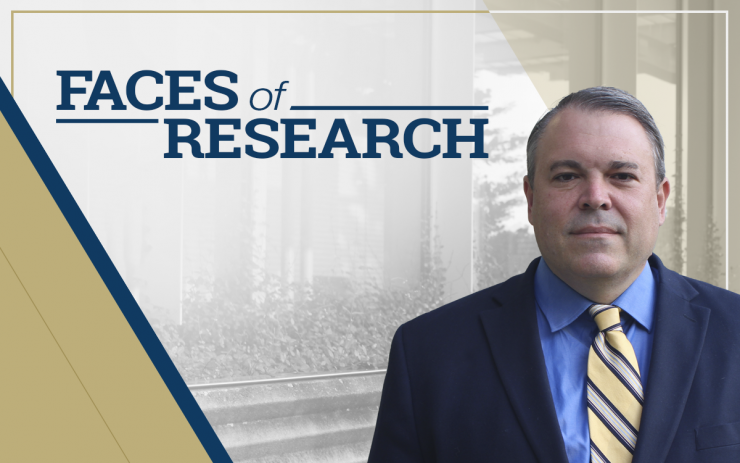Faces of Research - Meet Eric Vogel
Oct 18, 2021 — Atlanta, GA

Eric Vogel, executive director of Georgia Tech's Institute of Materials
Meet Eric Vogel, executive director of the Institute for Materials (IMat) at Georgia Tech.
IMat is one of Georgia Tech's 10 interdisciplinary research institutes (IRIs) within the Georgia Tech Research enterprise.
What is your field of expertise and why did you choose it?
My primary field of expertise is related to the synthesis, structure, properties and applications of various electronic and nanoscale materials and devices. I have always been fascinated by the idea that extremely small changes to the composition or structure of a material can have a dramatic impact on their electronic properties. My current research efforts are broad and interdisciplinary, including novel two-dimensional van der Waals materials, metal oxides for bio-inspired memory applications, surface interactions and application of electronic biosensors, and processes and materials for nano-modular devices for desktop integrated circuit manufacturing. I have always enjoyed working at the intersection of a variety of disciplines and my current research group includes Materials Scientists, Chemists, Electrical Engineers and Physicists.
What makes the way in which your IRI enables campus research unique?
The reach and impact of Georgia Tech's materials research is broad; from fundamental physics and chemistry, to simulation, synthesis, processing and characterization, to properties that impact structural, chemical, biomedical, electronic, optical, magnetic, thermal, and energy applications. IMat enables Tech's internationally recognized materials research and innovation ecosystem, from fundamental science to applications and policy; establishing and supporting large-scale industry- and government-funded partnerships and research centers, developing opportunities for Tech researchers to catalyze new teams and ideas, and establishing Tech as an internationally recognized hub for core materials research facilities and infrastructure.
We have recently established a team of nine initiative leads that cover a broad cross-section of materials research and:
· Assist IMat in identifying Tech strengths and gaps in a given materials research domain.
· Identify emerging research directions, opportunities for new large-scale research centers and partnerships, and new infrastructure needs in a given materials research domain.
· Build an inclusive and active community of interdisciplinary researchers across and beyond Tech in a given materials research domain using activities such as technical workshops.
· Enable Tech to create and respond to large-scale, multi-investigator extramural funding opportunities including large-scale research centers, and industry partnerships and consortia.
IMat has also helped to establish Tech as an internationally recognized hub for core materials research facilities and infrastructure through the Materials Characterization Facility (MCF) (mcf.gatech.edu). The MCF is a core user facility that serves over 700 users per year with a wide variety of microscopy and characterization tools as well as skilled research staff to support the needs of our users.
What couldn’t have happened without your IRI?
Research and associated funding continue to move towards more of a focus on larger, interdisciplinary teams and the need to connect discovery with translation. It is also becoming more and more recognized that creativity is fostered by the diversity of interdisciplinary exchange. IMat, and the other IRIs, are uniquely positioned to bring together faculty across Tech, independent of their discipline, to connect, develop transformative ideas ahead of our competitors and respond to large-scale proposal opportunities.
IMat is also uniquely positioned to provide core facilities such as the MCF. Many of the instruments within the MCF are extremely expensive, require extensive expertise and maintenance to operate, and have usage across many disciplines.
What impact is your IRI GT research having on the world?
Materials discovery is the foundation of many new technologies and is vital to economic growth as well as to the development of solutions to 21st century challenges in energy, mobility, infrastructure, computing, communications, security, and health.




